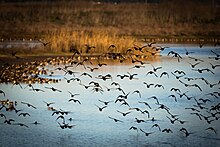Tagus Estuary Natural Reserve
This article needs additional citations for verification. (June 2012) |
| Tagus Estuary Natural Reserve | |
|---|---|
| Reserva Natural do Estuário do Tejo | |
IUCN category IV (habitat/species management area) | |
 Tagus Estuary, seen from Alcochete. | |
Map of Portugal | |
| Location | Lisbon District, Portugal |
| Nearest city | Lisbon |
| Coordinates | 38°49′16″N 8°59′35″W / 38.821°N 8.993°W[1] |
| Area | 14,192 ha (35,070 acres) |
| Established | 1976 |
| Official name | Estuário do Tejo |
| Designated | 24 November 1980 |
| Reference no. | 211[2] |
Tagus Estuary Natural Reserve (
Characterization

The Nature Reserve was established in 1976, covering an area of 14,192 hectares (35,070 acres), characterized by an extensive surface of estuarine waters, vast fields intersected by creeks, marshes, salt flats and alluvial agricultural land (marshlands).
Not exceeding 11 metres (36 ft) above sea level and a depth of 10 metres (33 ft), distributed over the counties of Alcochete, Benavente and Vila Franca de Xira, the reserve falls mostly in the upstream area of the estuary of the Tagus which, with an area extending over about 32 km2 (12 sq mi), is the largest in Western Europe.
Around the estuary a

In the wetlands around the estuary nesting birds include
Nearby patches of woodland hold short-toed treecreeper (Certhia brachydactyla), European nightjar (Caprimulgus europaeus), red-necked nightjar (Caprimulgus ruficollis), Iberian magpie (Cyanopica cooki) and many passerines.
During the Spring and Autumn many species stopover on the Tagus during their migration these include curlew sandpiper (Calidris ferruginea) in large numbers with many other shorebirds in smaller numbers, common redshank (Tringa totanus) and black-tailed godwits reach their peak numbers during migration too. Other migrants which may be seen include Eurasian spoonbill (Platalea alba), Mediterranean gull (Larus melanocephalus) and black tern (Chlidonias niger) and many passerines.[3]
Conservation status
- 1976 - The Natural Reserve of the Tagus Estuary is created through Decree-Law No. 565/76.
- 1980 - The reserve is designated as Wetlands of International Importance by the Ramsar Convention.
- 1994 - a Special Protection Area for Wild Birds is established under Directive 79/409/EEC.
References
- ^ "Estuário do Tejo Nature Reserve". protectedplanet.net.
- ^ "Estuário do Tejo". Ramsar Sites Information Service. Retrieved 25 April 2018.
- ^ "Tagus Estuary - BirdForum Opus".

